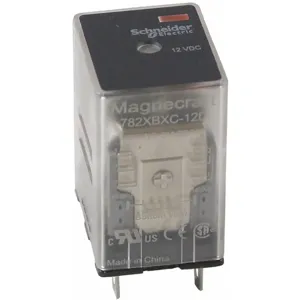Schneider Electric 782XBXC-24D general-purpose relay is used in industrial and commercial applications to control electrical circuits by opening or closing contacts when activated.
Features:
- Schneider relay (24VDC, 8 pin with square base) features tab-style electrical connections, providing a secure and reliable means to connect it to circuits, ensuring stable electrical connections.
- It has a socket mounting style, which simplifies installation and replacement without the need for tools.
- This general-purpose relay has eight pins or terminals for making electrical connections to enable the relay to interface with the control system effectively.
- It can handle a maximum current of 15 amperes, making it suitable for applications with moderate electrical loads.
- This 8 pin socket mounted general purpose relay has DPDT contacts for two sets of contacts that can switch between two independent circuits.
- It has a mechanical flag status indicator that serves as a visual indicator of the relay's status, making it easy to identify when it's active or not.
Frequently Asked Questions:
Q. What is the difference between a fuse holder and a fuse block?
A. A fuse holder, often installed in-line, is designed to accommodate a single fuse. In contrast, a fuse block is a larger device capable of housing up to twelve individual fuses, signifying a notable difference in capacity and functionality.
Q. What is the significance of the DPDT contact form in this relay?
A. DPDT (Double-Pole Double-Throw) means that the relay has two sets of contacts, each capable of switching between two independent circuits. This feature allows for versatile control and is beneficial in applications that require complex switching configurations.
Q. Why is the electrical and mechanical operating durability important for this Schneider 24VDC, 8 pin relay with square base?
A. The electrical operating durability (100000 operations) and mechanical operating durability (10000000 operations) indicate the relay's lifespan and reliability. These figures assure users that the relay can endure frequent operations, making it suitable for long-term use in industrial settings.
Q. How does the mechanical flag status indicator work?
A. The mechanical flag serves as a visual indicator of the relay's status. When the relay is energised or activated, the flag typically moves to a different position, providing a quick and easy way to visually confirm its operational status.










